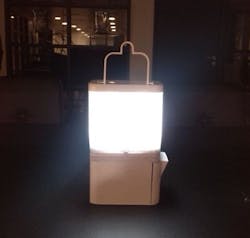Sustainable Alternative Lighting (SALt) develops LED lamp fueled by salt water
The company named SALt (Philippines) has developed a truly sustainable lamp that eliminates the cost and danger associated with the use of kerosene and battery powered lamps and candles used by third-world and impoverished nations and individuals. The light-emitting diode-based lamp provides a more efficient light source for people who use kerosene lamps and candles as an alternative source of lighting. The consumables of this lamp only need to be replaced every 6 months. The SALt lamp operates 8 hours a day every day, with proper maintenance, with an anode lifespan of 6 months.
Powered by salt water, the LED lamp glows safely because there are no materials and components inside the lamp that can cause fire accidents. The company says the lamp uses the science behind the galvanic cell, the basis for battery-making, changing the electrolytes to a non-toxic, saline solution—making the entire process safe and harmless. And for emergencies, you can charge your smartphone using this lamp. Just plug in your USB cable.
The company says that according to a study conducted by the United Nations, The Philippines ranked 3rd as the most disaster prone country in the whole world. And in disaster situations such as super typhoons, earthquakes—a steady supply of food, drinking water and a sustainable light source is very essential. The lamp also does not emit harmful gasses and leaves a minimal carbon footprint making it very environmentally friendly. And if the user lives along the coastline, ocean water can power the lamp.
The company does not yet have a physical store and is trying to scale its business to meet demand. A price has not yet been established, but the company plans to get the lamp out in the market before the year ends or first quarter of next year. Their current priority is to build lamps for its target communities and for the communities of the NGOs and foundations that will partner with them.
SOURCE: SALt; http://salt.strikingly.com/

Gail Overton | Senior Editor (2004-2020)
Gail has more than 30 years of engineering, marketing, product management, and editorial experience in the photonics and optical communications industry. Before joining the staff at Laser Focus World in 2004, she held many product management and product marketing roles in the fiber-optics industry, most notably at Hughes (El Segundo, CA), GTE Labs (Waltham, MA), Corning (Corning, NY), Photon Kinetics (Beaverton, OR), and Newport Corporation (Irvine, CA). During her marketing career, Gail published articles in WDM Solutions and Sensors magazine and traveled internationally to conduct product and sales training. Gail received her BS degree in physics, with an emphasis in optics, from San Diego State University in San Diego, CA in May 1986.
